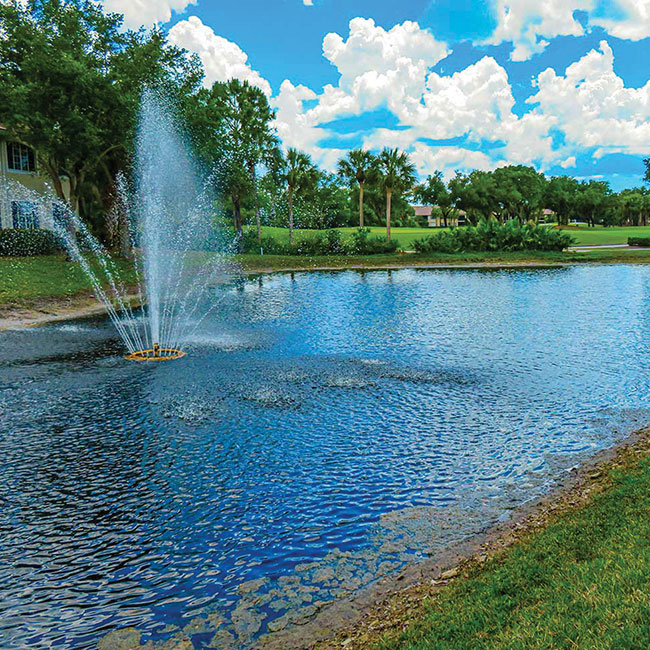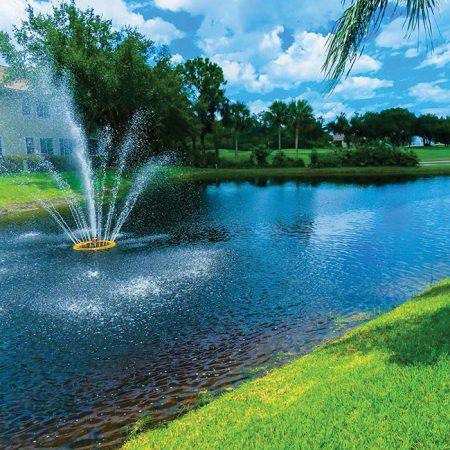
Features
Profiles
Nanobubbles: a chemical-free solution for algae
Tiny bubbles eliminate harmful algae and the buildup of unwanted odours
October 14, 2020 By Christian Ference
 Photo shows algae buildup along pond bank.
Photo shows algae buildup along pond bank. Many Golf Clubs have become world-renowned because of their elaborate water features, from Grand National Lake Course to Coeur d’Alene. These ornamental water features can be both a source of attraction for golfers and a money drain for golf clubs due to extensive maintenance costs.
Golf course ponds are particularly prone to nutrient runoff from fertilizers and turf treatments, which makes the maintenance of these water bodies all the more challenging.
Ponds and water features on golf courses are often shallow, stagnant, and warmer throughout the spring and summer seasons. This depletes these waterways of dissolved oxygen, which in turn creates an environment that’s ideal for bacteria and algae growth.
Maintenance of these features has traditionally been done either by using chemicals (algaecides), by bottom-mounted aerators or fountains. Oftentimes these methods are ineffective in resolving long-term imbalances in dissolved oxygen, nitrogen and phosphorus levels. These methods require recurring costs and are less effective for golf or pond management companies, and can also require submerged piping systems that are both labour and capital intensive.
How conventional aeration work
Bottom mounted aeration circulates water, relying on mixing of the water to improve dissolved oxygen instead of gas transfer from the bubbles themselves. However, this solution to preventing algae blooms is often ineffective in small, shallow ponds and water features found at most golf courses. This is because aeration creates large bubbles of air that can quickly rise to the surface and escape in shallow bodies of water, so oxygen transfer to the water is limited, with an oxygen transfer efficiency (OTE) rate of one per cent to three per cent per foot of water.

Photo shows the buildup has diminished.
How algaecide chemicals work
Using chemicals to treat ponds and clean water features is effective but can quickly become costly and can have negative effects on the aquatic ecosystem and human health.
If maintenance employees are not especially careful, adding the incorrect amount of chemical mixture can vastly impact the water body. Too high a dosage can cause the pH levels in the water to plummet, killing off the aquatic ecosystem, which can in turn put the aquatic life that inhabits the waterbody at risk.
Additionally, if the pond has had a buildup of algae, the algae cells can be disrupted too quickly causing the release of toxins that can become airborne, which have proven to cause human respiratory irritations. This can quickly lead to significant complaints from golfers and prompt health concerns.
A new alternative: nanobubbles
Golf courses have turned their attention to a new, cost-effective method for accelerating the treatment of ponds and water bodies, eliminating harmful algae and the buildup of unwanted odours.
Nanobubbles are tiny bubbles that are 2,500 times smaller than a grain of table salt. These bubbles are so tiny, that they don’t float to the surface. Instead, these bubbles follow a process called Brownian motion, where they stay suspended in the water for long periods of time, moving throughout the entire water column due to the natural mixing of the water. There are three main benefits to using nanobubbles to treat water.
Nanobubbles provide a long-term, cost-effective solution for maintaining and improving golf course water features:
- Nanobubbles provide a cost-effective method for ongoing golf course pond maintenance. Nanobubble generators are not as energy or labour intensive as traditional aeration methods, and do not require expensive chemicals. Nanobubble generators are a simple, shore-mounted, plug-and-play system that can be easily installed with minimal technical setup.
Nanobubbles reduce the need for chemicals, and improve pond water clarity:
- Nanobubbles break down organic debris through a mild oxidative impact and positively affect oxidation reduction potential, which is the ability for a water body to cleanse itself or break down waste products. It’s the tiny size of oxygen nanobubbles that gives them a negative surface charge to help them break down unwanted organic compounds, eliminate their toxicity or reduce them to harmless products like carbon dioxide, water, and salts.
Nanobubbles are an effective, sustainable solution to improving and maintaining aquatic ecosystem health during golf season’s warmer months:
- Nanobubbles dissolve nearly all their oxygen into the water, returning the aquatic ecosystem to balance, preventing buildups of unsustainable levels of nitrogen and phosphorus, and mitigating against harmful bacteria and pathogens. Nanobubbles effectively oxygenate water in warm temperatures independent of depth, providing an advantage over traditional aeration methods. This helps prevent the outbreak of harmful algae blooms and obnoxious odours that can disturb golfers and spectators.
Nanobubbles also improve the water quality for irrigation purposes. Oxygen-filled nanobubbles have significantly improved water quality and fungicides’ effectiveness for irrigation, preventing course browning from heat stress and fungi. This is the result of better dissolution of pesticides, and the inhibition of certain anaerobic pathogens (botrytis, pythium, and alternaria), and microorganisms (salmonella and E coli).
Final word
Nanobubbles are already being used to treat more than a dozen golf courses across the world, including several PGA courses, and this trend is expected to continue. Moleaer, is a leading nanobubble technology company, developing and deploying nanobubble generators to treat ponds, lakes, and water features throughout North America. Moleaer’s technology has cleaned dozens of golf course ponds in Florida, managed by SOLitude Lake Management, a leading pond management company.
Treating water, whether it’s a small pond or a large lake, can be a challenge – and this challenge is only going to intensify with climate change. The fast-growing nanobubble industry provides a sustainable, cost-efficient, and chemical-free solution to treat almost any water body.
Christian Ference is an application engineer with Moleaer Inc.
Print this page